Corporate Social Responsibility for Indigenous Australian Communities
VerifiedAdded on 2020/05/28
|9
|2032
|85
Report
AI Summary
This report investigates the impact of business operations, particularly mining, on Indigenous Australian communities, focusing on land, environment, and cultural preservation. It begins with an introduction to the issue, highlighting the importance of Corporate Social Responsibility (CSR) in mitigating conflicts and promoting peaceful operations. The background section delves into the foundational aspects of Indigenous Australian cultures, including the Dreaming and economic organization, as well as the historical impact of colonization, policies, and legislation. The report then examines the current position of Indigenous Australians, discussing the socio-economic disadvantages they face due to historical and ongoing factors. It also addresses the challenges businesses pose to Indigenous culture, land, and the environment. The report concludes with recommendations for businesses to promote sustainable practices, protect cultural heritage, and provide socio-economic benefits to Indigenous communities through employment, healthcare, and education. Reference lists are also provided.
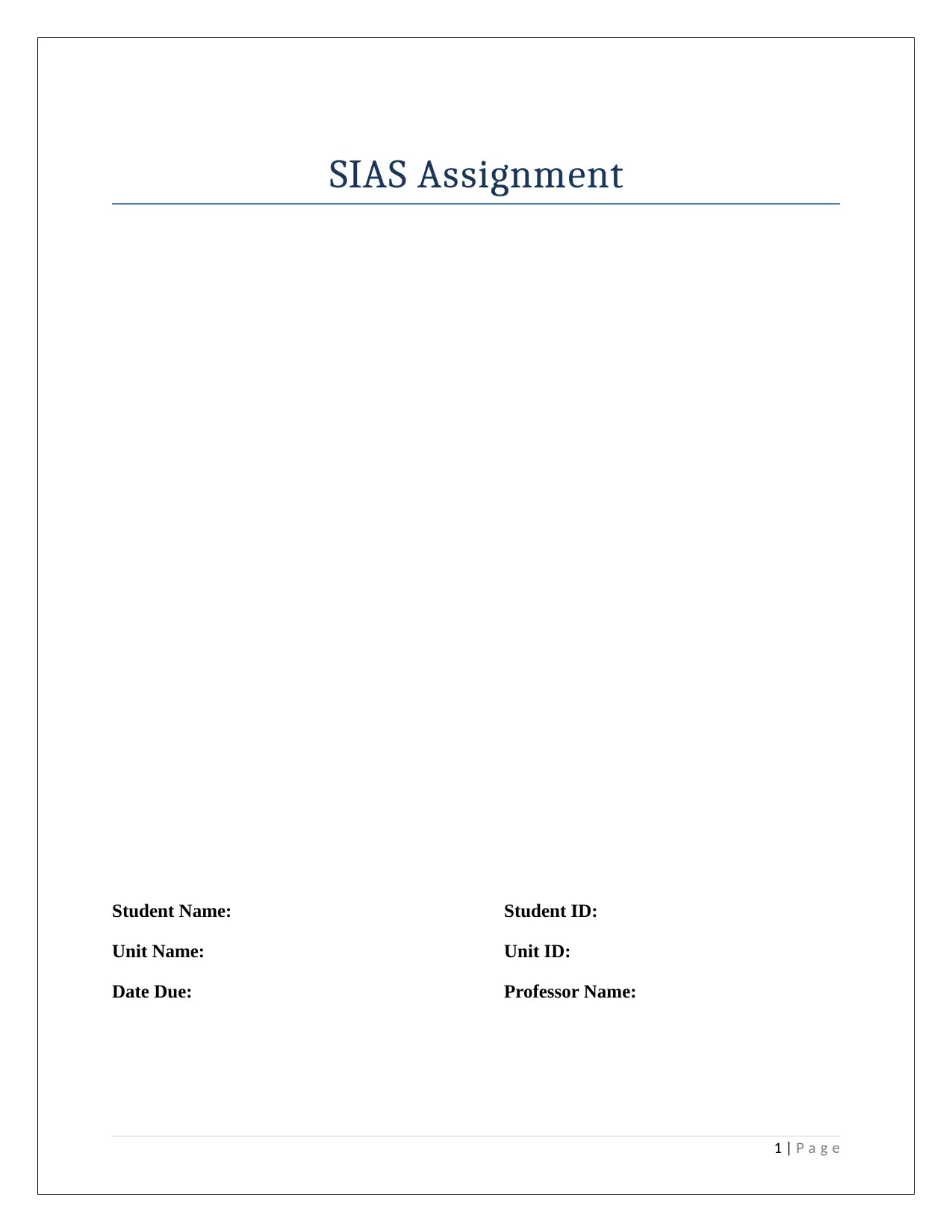
SIAS Assignment
Student Name: Student ID:
Unit Name: Unit ID:
Date Due: Professor Name:
1 | P a g e
Student Name: Student ID:
Unit Name: Unit ID:
Date Due: Professor Name:
1 | P a g e
Paraphrase This Document
Need a fresh take? Get an instant paraphrase of this document with our AI Paraphraser
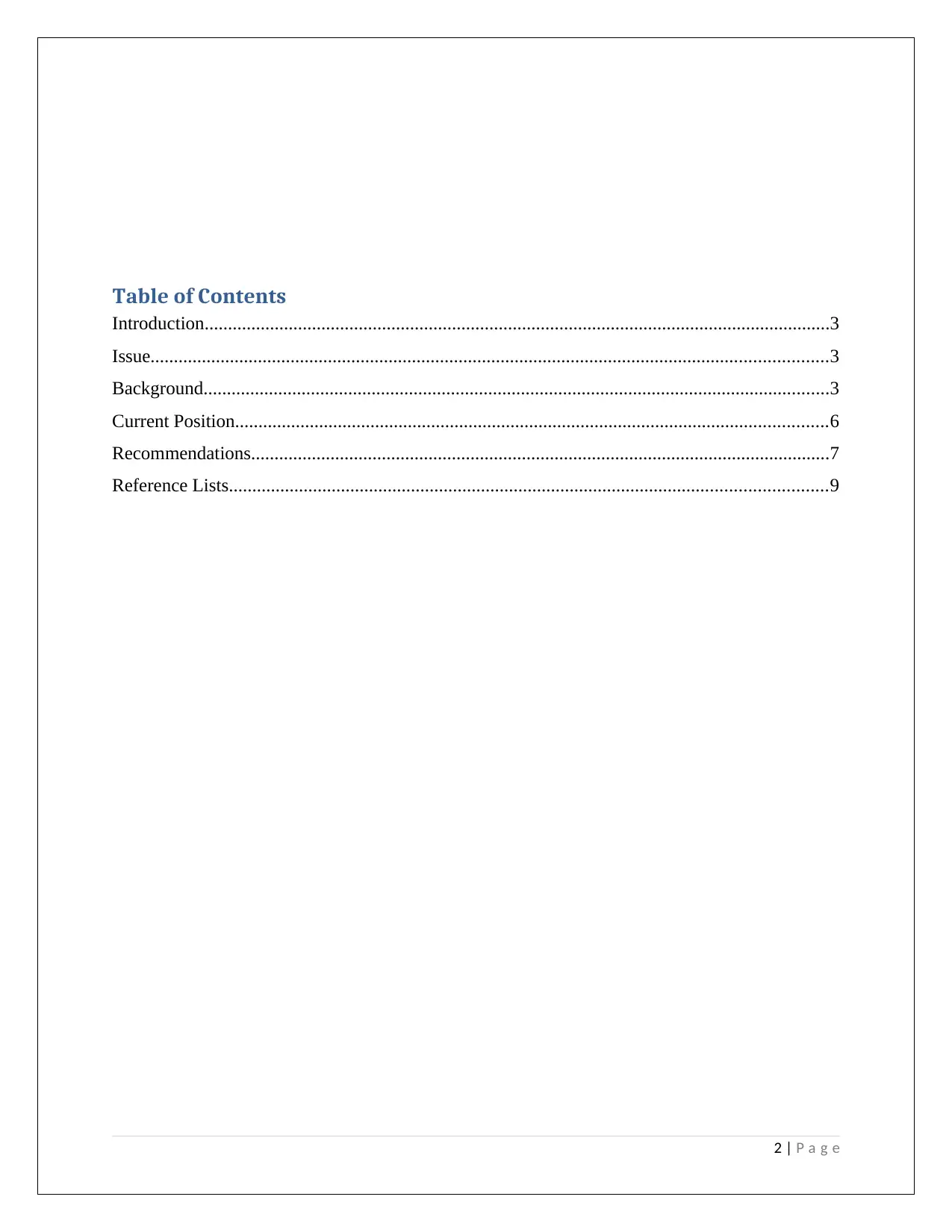
Table of Contents
Introduction......................................................................................................................................3
Issue.................................................................................................................................................3
Background......................................................................................................................................3
Current Position...............................................................................................................................6
Recommendations............................................................................................................................7
Reference Lists................................................................................................................................9
2 | P a g e
Introduction......................................................................................................................................3
Issue.................................................................................................................................................3
Background......................................................................................................................................3
Current Position...............................................................................................................................6
Recommendations............................................................................................................................7
Reference Lists................................................................................................................................9
2 | P a g e
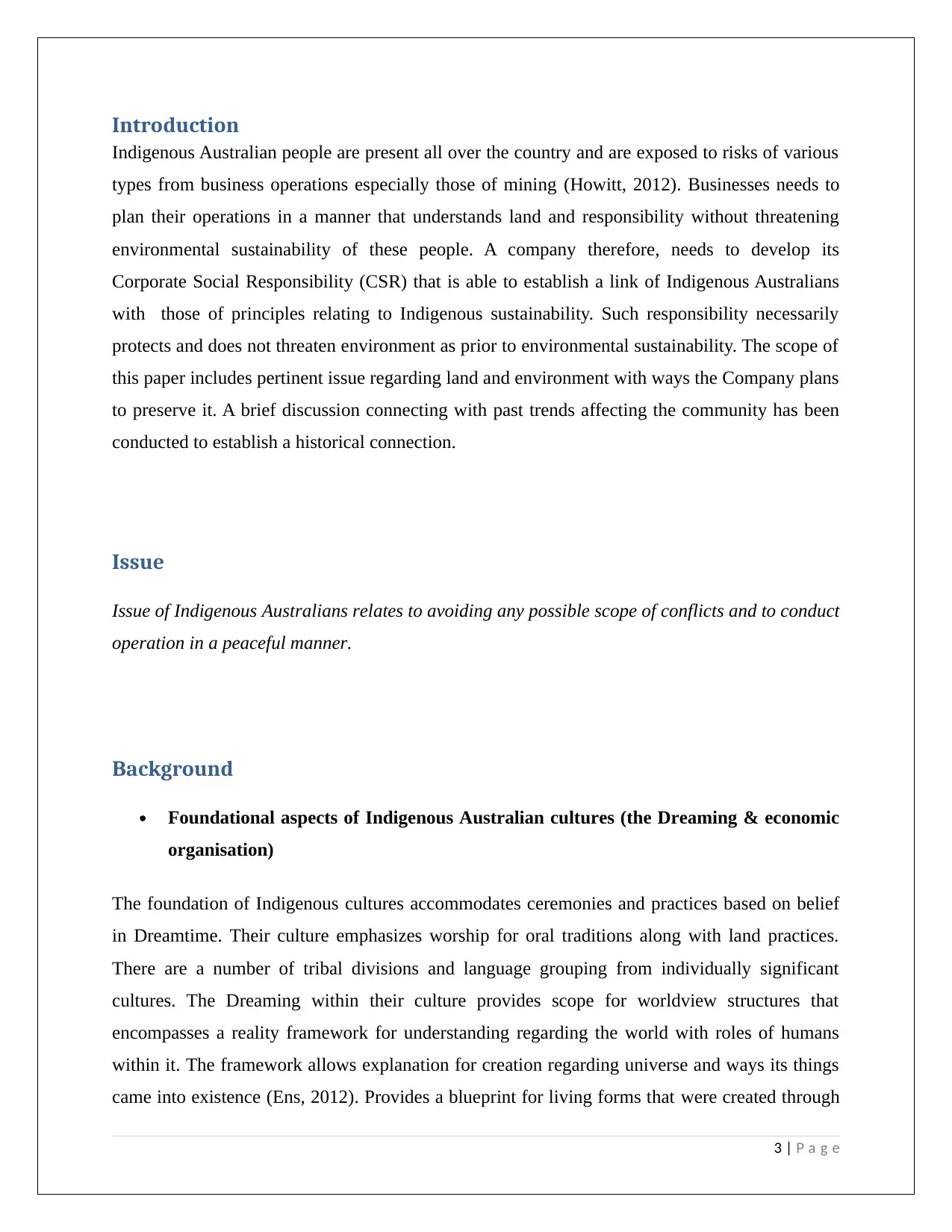
Introduction
Indigenous Australian people are present all over the country and are exposed to risks of various
types from business operations especially those of mining (Howitt, 2012). Businesses needs to
plan their operations in a manner that understands land and responsibility without threatening
environmental sustainability of these people. A company therefore, needs to develop its
Corporate Social Responsibility (CSR) that is able to establish a link of Indigenous Australians
with those of principles relating to Indigenous sustainability. Such responsibility necessarily
protects and does not threaten environment as prior to environmental sustainability. The scope of
this paper includes pertinent issue regarding land and environment with ways the Company plans
to preserve it. A brief discussion connecting with past trends affecting the community has been
conducted to establish a historical connection.
Issue
Issue of Indigenous Australians relates to avoiding any possible scope of conflicts and to conduct
operation in a peaceful manner.
Background
Foundational aspects of Indigenous Australian cultures (the Dreaming & economic
organisation)
The foundation of Indigenous cultures accommodates ceremonies and practices based on belief
in Dreamtime. Their culture emphasizes worship for oral traditions along with land practices.
There are a number of tribal divisions and language grouping from individually significant
cultures. The Dreaming within their culture provides scope for worldview structures that
encompasses a reality framework for understanding regarding the world with roles of humans
within it. The framework allows explanation for creation regarding universe and ways its things
came into existence (Ens, 2012). Provides a blueprint for living forms that were created through
3 | P a g e
Indigenous Australian people are present all over the country and are exposed to risks of various
types from business operations especially those of mining (Howitt, 2012). Businesses needs to
plan their operations in a manner that understands land and responsibility without threatening
environmental sustainability of these people. A company therefore, needs to develop its
Corporate Social Responsibility (CSR) that is able to establish a link of Indigenous Australians
with those of principles relating to Indigenous sustainability. Such responsibility necessarily
protects and does not threaten environment as prior to environmental sustainability. The scope of
this paper includes pertinent issue regarding land and environment with ways the Company plans
to preserve it. A brief discussion connecting with past trends affecting the community has been
conducted to establish a historical connection.
Issue
Issue of Indigenous Australians relates to avoiding any possible scope of conflicts and to conduct
operation in a peaceful manner.
Background
Foundational aspects of Indigenous Australian cultures (the Dreaming & economic
organisation)
The foundation of Indigenous cultures accommodates ceremonies and practices based on belief
in Dreamtime. Their culture emphasizes worship for oral traditions along with land practices.
There are a number of tribal divisions and language grouping from individually significant
cultures. The Dreaming within their culture provides scope for worldview structures that
encompasses a reality framework for understanding regarding the world with roles of humans
within it. The framework allows explanation for creation regarding universe and ways its things
came into existence (Ens, 2012). Provides a blueprint for living forms that were created through
3 | P a g e
⊘ This is a preview!⊘
Do you want full access?
Subscribe today to unlock all pages.

Trusted by 1+ million students worldwide
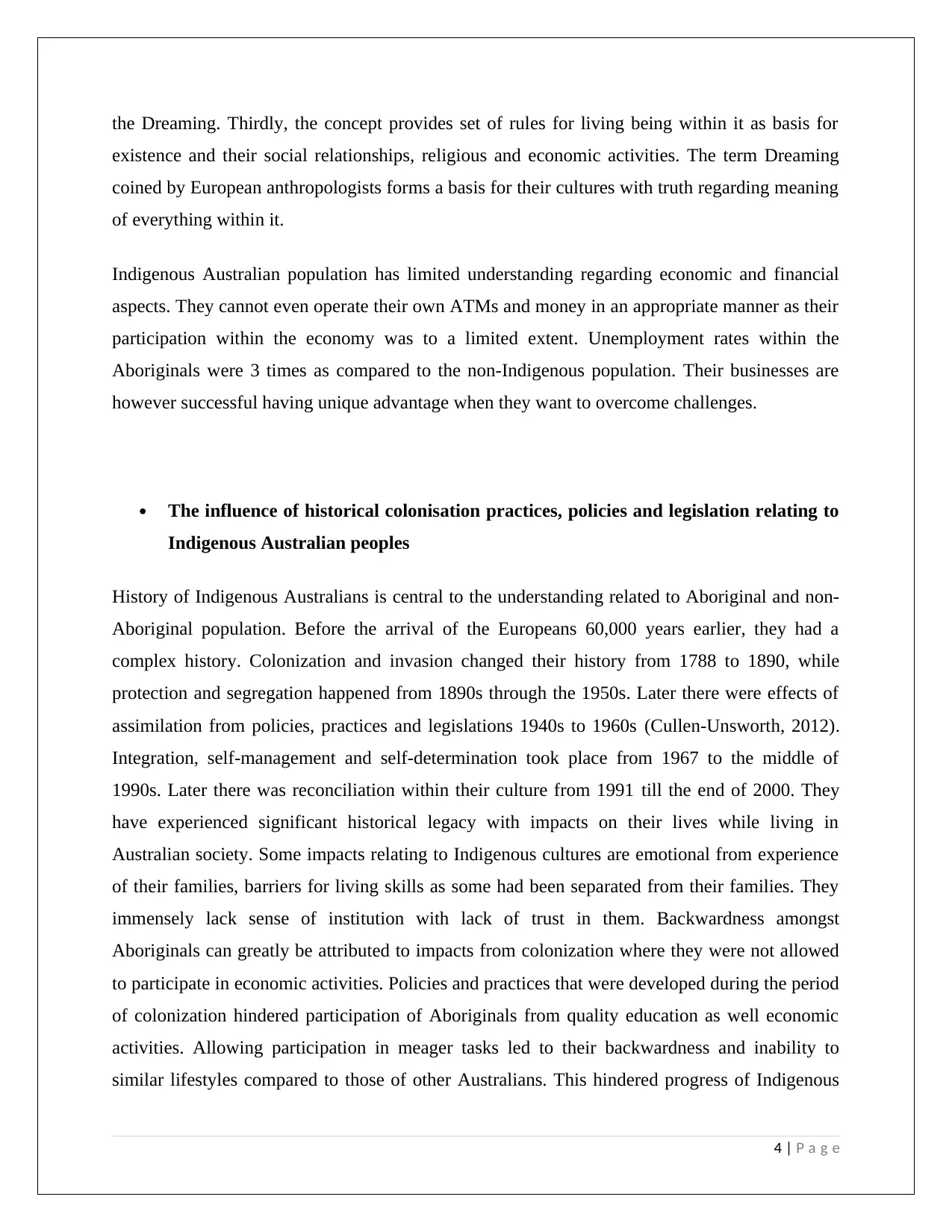
the Dreaming. Thirdly, the concept provides set of rules for living being within it as basis for
existence and their social relationships, religious and economic activities. The term Dreaming
coined by European anthropologists forms a basis for their cultures with truth regarding meaning
of everything within it.
Indigenous Australian population has limited understanding regarding economic and financial
aspects. They cannot even operate their own ATMs and money in an appropriate manner as their
participation within the economy was to a limited extent. Unemployment rates within the
Aboriginals were 3 times as compared to the non-Indigenous population. Their businesses are
however successful having unique advantage when they want to overcome challenges.
The influence of historical colonisation practices, policies and legislation relating to
Indigenous Australian peoples
History of Indigenous Australians is central to the understanding related to Aboriginal and non-
Aboriginal population. Before the arrival of the Europeans 60,000 years earlier, they had a
complex history. Colonization and invasion changed their history from 1788 to 1890, while
protection and segregation happened from 1890s through the 1950s. Later there were effects of
assimilation from policies, practices and legislations 1940s to 1960s (Cullen‐Unsworth, 2012).
Integration, self-management and self-determination took place from 1967 to the middle of
1990s. Later there was reconciliation within their culture from 1991 till the end of 2000. They
have experienced significant historical legacy with impacts on their lives while living in
Australian society. Some impacts relating to Indigenous cultures are emotional from experience
of their families, barriers for living skills as some had been separated from their families. They
immensely lack sense of institution with lack of trust in them. Backwardness amongst
Aboriginals can greatly be attributed to impacts from colonization where they were not allowed
to participate in economic activities. Policies and practices that were developed during the period
of colonization hindered participation of Aboriginals from quality education as well economic
activities. Allowing participation in meager tasks led to their backwardness and inability to
similar lifestyles compared to those of other Australians. This hindered progress of Indigenous
4 | P a g e
existence and their social relationships, religious and economic activities. The term Dreaming
coined by European anthropologists forms a basis for their cultures with truth regarding meaning
of everything within it.
Indigenous Australian population has limited understanding regarding economic and financial
aspects. They cannot even operate their own ATMs and money in an appropriate manner as their
participation within the economy was to a limited extent. Unemployment rates within the
Aboriginals were 3 times as compared to the non-Indigenous population. Their businesses are
however successful having unique advantage when they want to overcome challenges.
The influence of historical colonisation practices, policies and legislation relating to
Indigenous Australian peoples
History of Indigenous Australians is central to the understanding related to Aboriginal and non-
Aboriginal population. Before the arrival of the Europeans 60,000 years earlier, they had a
complex history. Colonization and invasion changed their history from 1788 to 1890, while
protection and segregation happened from 1890s through the 1950s. Later there were effects of
assimilation from policies, practices and legislations 1940s to 1960s (Cullen‐Unsworth, 2012).
Integration, self-management and self-determination took place from 1967 to the middle of
1990s. Later there was reconciliation within their culture from 1991 till the end of 2000. They
have experienced significant historical legacy with impacts on their lives while living in
Australian society. Some impacts relating to Indigenous cultures are emotional from experience
of their families, barriers for living skills as some had been separated from their families. They
immensely lack sense of institution with lack of trust in them. Backwardness amongst
Aboriginals can greatly be attributed to impacts from colonization where they were not allowed
to participate in economic activities. Policies and practices that were developed during the period
of colonization hindered participation of Aboriginals from quality education as well economic
activities. Allowing participation in meager tasks led to their backwardness and inability to
similar lifestyles compared to those of other Australians. This hindered progress of Indigenous
4 | P a g e
Paraphrase This Document
Need a fresh take? Get an instant paraphrase of this document with our AI Paraphraser
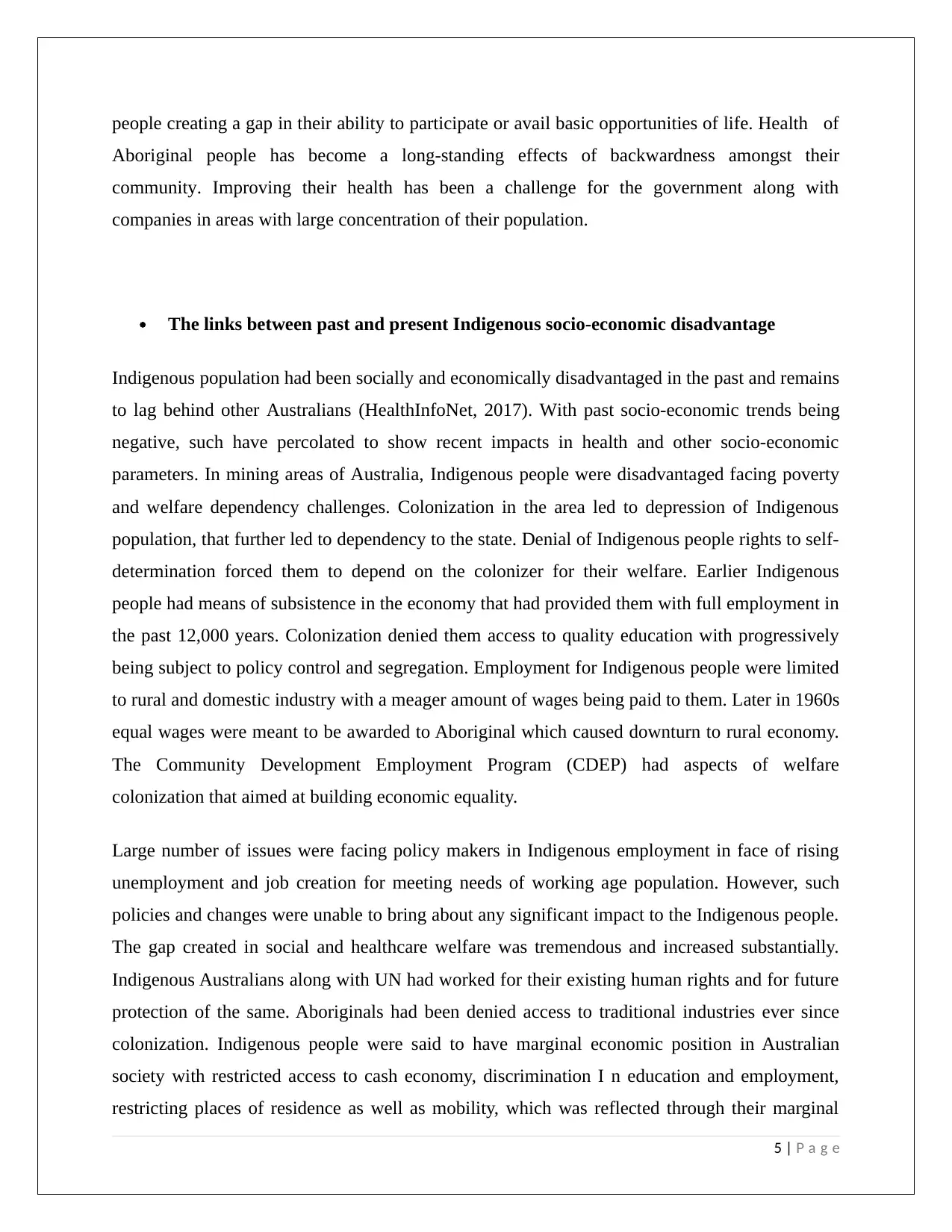
people creating a gap in their ability to participate or avail basic opportunities of life. Health of
Aboriginal people has become a long-standing effects of backwardness amongst their
community. Improving their health has been a challenge for the government along with
companies in areas with large concentration of their population.
The links between past and present Indigenous socio-economic disadvantage
Indigenous population had been socially and economically disadvantaged in the past and remains
to lag behind other Australians (HealthInfoNet, 2017). With past socio-economic trends being
negative, such have percolated to show recent impacts in health and other socio-economic
parameters. In mining areas of Australia, Indigenous people were disadvantaged facing poverty
and welfare dependency challenges. Colonization in the area led to depression of Indigenous
population, that further led to dependency to the state. Denial of Indigenous people rights to self-
determination forced them to depend on the colonizer for their welfare. Earlier Indigenous
people had means of subsistence in the economy that had provided them with full employment in
the past 12,000 years. Colonization denied them access to quality education with progressively
being subject to policy control and segregation. Employment for Indigenous people were limited
to rural and domestic industry with a meager amount of wages being paid to them. Later in 1960s
equal wages were meant to be awarded to Aboriginal which caused downturn to rural economy.
The Community Development Employment Program (CDEP) had aspects of welfare
colonization that aimed at building economic equality.
Large number of issues were facing policy makers in Indigenous employment in face of rising
unemployment and job creation for meeting needs of working age population. However, such
policies and changes were unable to bring about any significant impact to the Indigenous people.
The gap created in social and healthcare welfare was tremendous and increased substantially.
Indigenous Australians along with UN had worked for their existing human rights and for future
protection of the same. Aboriginals had been denied access to traditional industries ever since
colonization. Indigenous people were said to have marginal economic position in Australian
society with restricted access to cash economy, discrimination I n education and employment,
restricting places of residence as well as mobility, which was reflected through their marginal
5 | P a g e
Aboriginal people has become a long-standing effects of backwardness amongst their
community. Improving their health has been a challenge for the government along with
companies in areas with large concentration of their population.
The links between past and present Indigenous socio-economic disadvantage
Indigenous population had been socially and economically disadvantaged in the past and remains
to lag behind other Australians (HealthInfoNet, 2017). With past socio-economic trends being
negative, such have percolated to show recent impacts in health and other socio-economic
parameters. In mining areas of Australia, Indigenous people were disadvantaged facing poverty
and welfare dependency challenges. Colonization in the area led to depression of Indigenous
population, that further led to dependency to the state. Denial of Indigenous people rights to self-
determination forced them to depend on the colonizer for their welfare. Earlier Indigenous
people had means of subsistence in the economy that had provided them with full employment in
the past 12,000 years. Colonization denied them access to quality education with progressively
being subject to policy control and segregation. Employment for Indigenous people were limited
to rural and domestic industry with a meager amount of wages being paid to them. Later in 1960s
equal wages were meant to be awarded to Aboriginal which caused downturn to rural economy.
The Community Development Employment Program (CDEP) had aspects of welfare
colonization that aimed at building economic equality.
Large number of issues were facing policy makers in Indigenous employment in face of rising
unemployment and job creation for meeting needs of working age population. However, such
policies and changes were unable to bring about any significant impact to the Indigenous people.
The gap created in social and healthcare welfare was tremendous and increased substantially.
Indigenous Australians along with UN had worked for their existing human rights and for future
protection of the same. Aboriginals had been denied access to traditional industries ever since
colonization. Indigenous people were said to have marginal economic position in Australian
society with restricted access to cash economy, discrimination I n education and employment,
restricting places of residence as well as mobility, which was reflected through their marginal
5 | P a g e
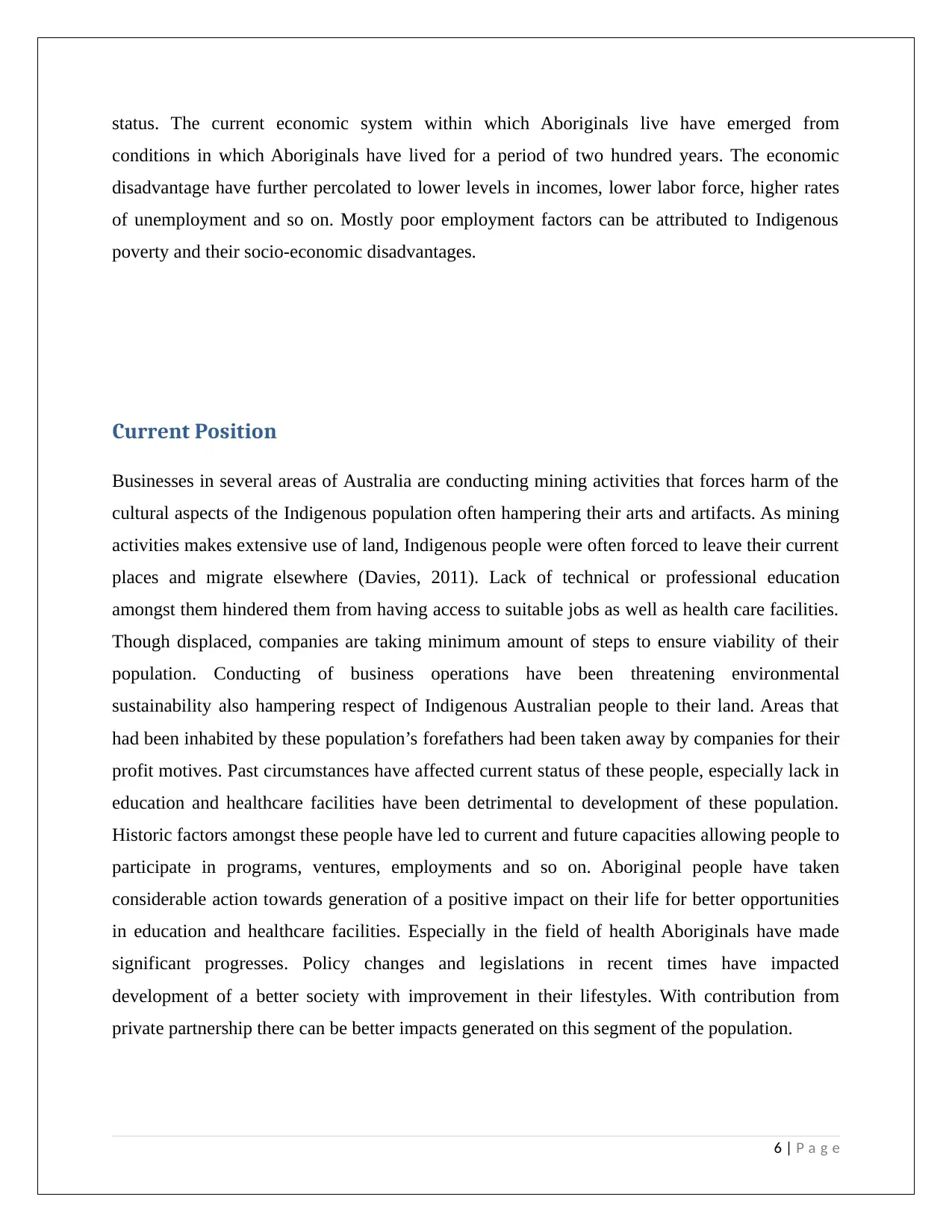
status. The current economic system within which Aboriginals live have emerged from
conditions in which Aboriginals have lived for a period of two hundred years. The economic
disadvantage have further percolated to lower levels in incomes, lower labor force, higher rates
of unemployment and so on. Mostly poor employment factors can be attributed to Indigenous
poverty and their socio-economic disadvantages.
Current Position
Businesses in several areas of Australia are conducting mining activities that forces harm of the
cultural aspects of the Indigenous population often hampering their arts and artifacts. As mining
activities makes extensive use of land, Indigenous people were often forced to leave their current
places and migrate elsewhere (Davies, 2011). Lack of technical or professional education
amongst them hindered them from having access to suitable jobs as well as health care facilities.
Though displaced, companies are taking minimum amount of steps to ensure viability of their
population. Conducting of business operations have been threatening environmental
sustainability also hampering respect of Indigenous Australian people to their land. Areas that
had been inhabited by these population’s forefathers had been taken away by companies for their
profit motives. Past circumstances have affected current status of these people, especially lack in
education and healthcare facilities have been detrimental to development of these population.
Historic factors amongst these people have led to current and future capacities allowing people to
participate in programs, ventures, employments and so on. Aboriginal people have taken
considerable action towards generation of a positive impact on their life for better opportunities
in education and healthcare facilities. Especially in the field of health Aboriginals have made
significant progresses. Policy changes and legislations in recent times have impacted
development of a better society with improvement in their lifestyles. With contribution from
private partnership there can be better impacts generated on this segment of the population.
6 | P a g e
conditions in which Aboriginals have lived for a period of two hundred years. The economic
disadvantage have further percolated to lower levels in incomes, lower labor force, higher rates
of unemployment and so on. Mostly poor employment factors can be attributed to Indigenous
poverty and their socio-economic disadvantages.
Current Position
Businesses in several areas of Australia are conducting mining activities that forces harm of the
cultural aspects of the Indigenous population often hampering their arts and artifacts. As mining
activities makes extensive use of land, Indigenous people were often forced to leave their current
places and migrate elsewhere (Davies, 2011). Lack of technical or professional education
amongst them hindered them from having access to suitable jobs as well as health care facilities.
Though displaced, companies are taking minimum amount of steps to ensure viability of their
population. Conducting of business operations have been threatening environmental
sustainability also hampering respect of Indigenous Australian people to their land. Areas that
had been inhabited by these population’s forefathers had been taken away by companies for their
profit motives. Past circumstances have affected current status of these people, especially lack in
education and healthcare facilities have been detrimental to development of these population.
Historic factors amongst these people have led to current and future capacities allowing people to
participate in programs, ventures, employments and so on. Aboriginal people have taken
considerable action towards generation of a positive impact on their life for better opportunities
in education and healthcare facilities. Especially in the field of health Aboriginals have made
significant progresses. Policy changes and legislations in recent times have impacted
development of a better society with improvement in their lifestyles. With contribution from
private partnership there can be better impacts generated on this segment of the population.
6 | P a g e
⊘ This is a preview!⊘
Do you want full access?
Subscribe today to unlock all pages.

Trusted by 1+ million students worldwide
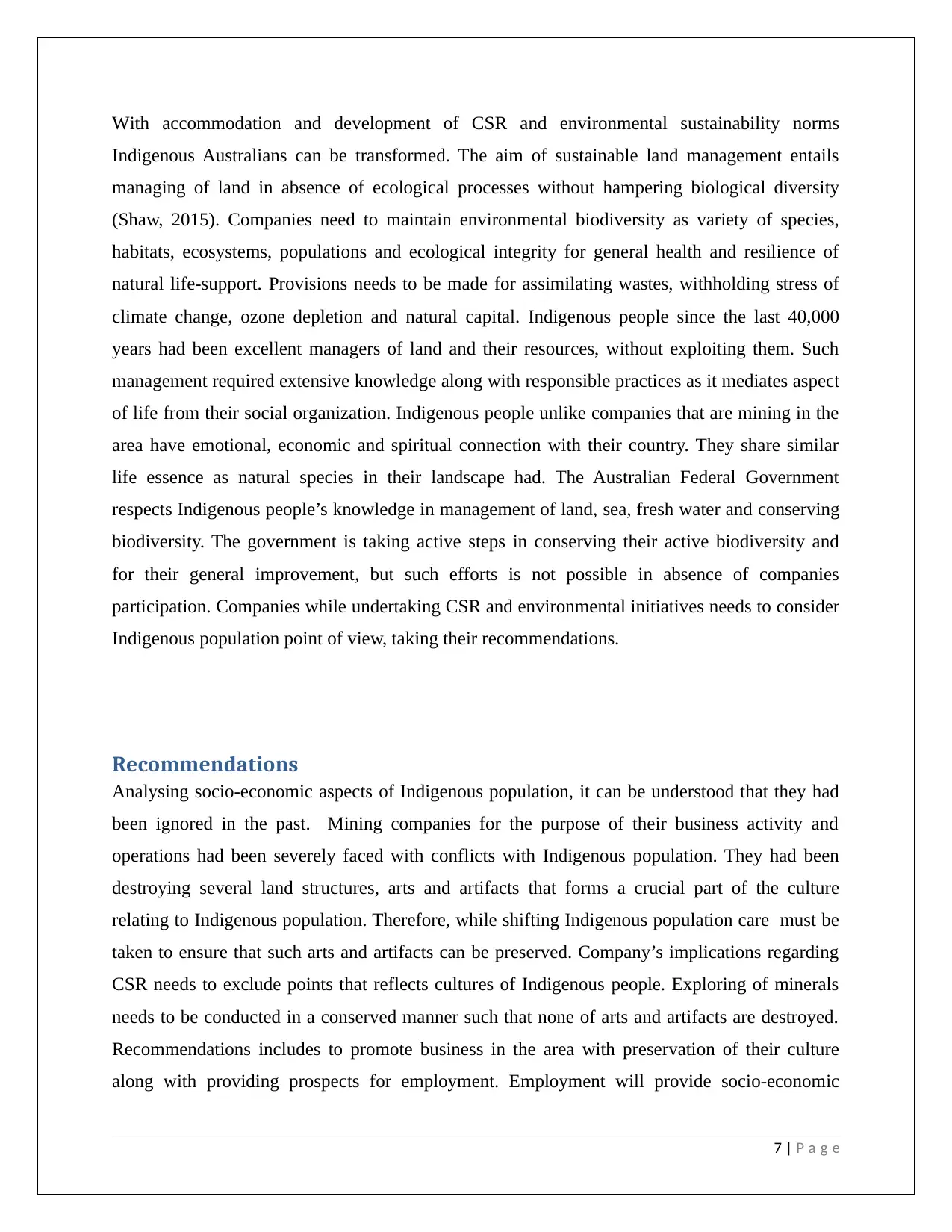
With accommodation and development of CSR and environmental sustainability norms
Indigenous Australians can be transformed. The aim of sustainable land management entails
managing of land in absence of ecological processes without hampering biological diversity
(Shaw, 2015). Companies need to maintain environmental biodiversity as variety of species,
habitats, ecosystems, populations and ecological integrity for general health and resilience of
natural life-support. Provisions needs to be made for assimilating wastes, withholding stress of
climate change, ozone depletion and natural capital. Indigenous people since the last 40,000
years had been excellent managers of land and their resources, without exploiting them. Such
management required extensive knowledge along with responsible practices as it mediates aspect
of life from their social organization. Indigenous people unlike companies that are mining in the
area have emotional, economic and spiritual connection with their country. They share similar
life essence as natural species in their landscape had. The Australian Federal Government
respects Indigenous people’s knowledge in management of land, sea, fresh water and conserving
biodiversity. The government is taking active steps in conserving their active biodiversity and
for their general improvement, but such efforts is not possible in absence of companies
participation. Companies while undertaking CSR and environmental initiatives needs to consider
Indigenous population point of view, taking their recommendations.
Recommendations
Analysing socio-economic aspects of Indigenous population, it can be understood that they had
been ignored in the past. Mining companies for the purpose of their business activity and
operations had been severely faced with conflicts with Indigenous population. They had been
destroying several land structures, arts and artifacts that forms a crucial part of the culture
relating to Indigenous population. Therefore, while shifting Indigenous population care must be
taken to ensure that such arts and artifacts can be preserved. Company’s implications regarding
CSR needs to exclude points that reflects cultures of Indigenous people. Exploring of minerals
needs to be conducted in a conserved manner such that none of arts and artifacts are destroyed.
Recommendations includes to promote business in the area with preservation of their culture
along with providing prospects for employment. Employment will provide socio-economic
7 | P a g e
Indigenous Australians can be transformed. The aim of sustainable land management entails
managing of land in absence of ecological processes without hampering biological diversity
(Shaw, 2015). Companies need to maintain environmental biodiversity as variety of species,
habitats, ecosystems, populations and ecological integrity for general health and resilience of
natural life-support. Provisions needs to be made for assimilating wastes, withholding stress of
climate change, ozone depletion and natural capital. Indigenous people since the last 40,000
years had been excellent managers of land and their resources, without exploiting them. Such
management required extensive knowledge along with responsible practices as it mediates aspect
of life from their social organization. Indigenous people unlike companies that are mining in the
area have emotional, economic and spiritual connection with their country. They share similar
life essence as natural species in their landscape had. The Australian Federal Government
respects Indigenous people’s knowledge in management of land, sea, fresh water and conserving
biodiversity. The government is taking active steps in conserving their active biodiversity and
for their general improvement, but such efforts is not possible in absence of companies
participation. Companies while undertaking CSR and environmental initiatives needs to consider
Indigenous population point of view, taking their recommendations.
Recommendations
Analysing socio-economic aspects of Indigenous population, it can be understood that they had
been ignored in the past. Mining companies for the purpose of their business activity and
operations had been severely faced with conflicts with Indigenous population. They had been
destroying several land structures, arts and artifacts that forms a crucial part of the culture
relating to Indigenous population. Therefore, while shifting Indigenous population care must be
taken to ensure that such arts and artifacts can be preserved. Company’s implications regarding
CSR needs to exclude points that reflects cultures of Indigenous people. Exploring of minerals
needs to be conducted in a conserved manner such that none of arts and artifacts are destroyed.
Recommendations includes to promote business in the area with preservation of their culture
along with providing prospects for employment. Employment will provide socio-economic
7 | P a g e
Paraphrase This Document
Need a fresh take? Get an instant paraphrase of this document with our AI Paraphraser
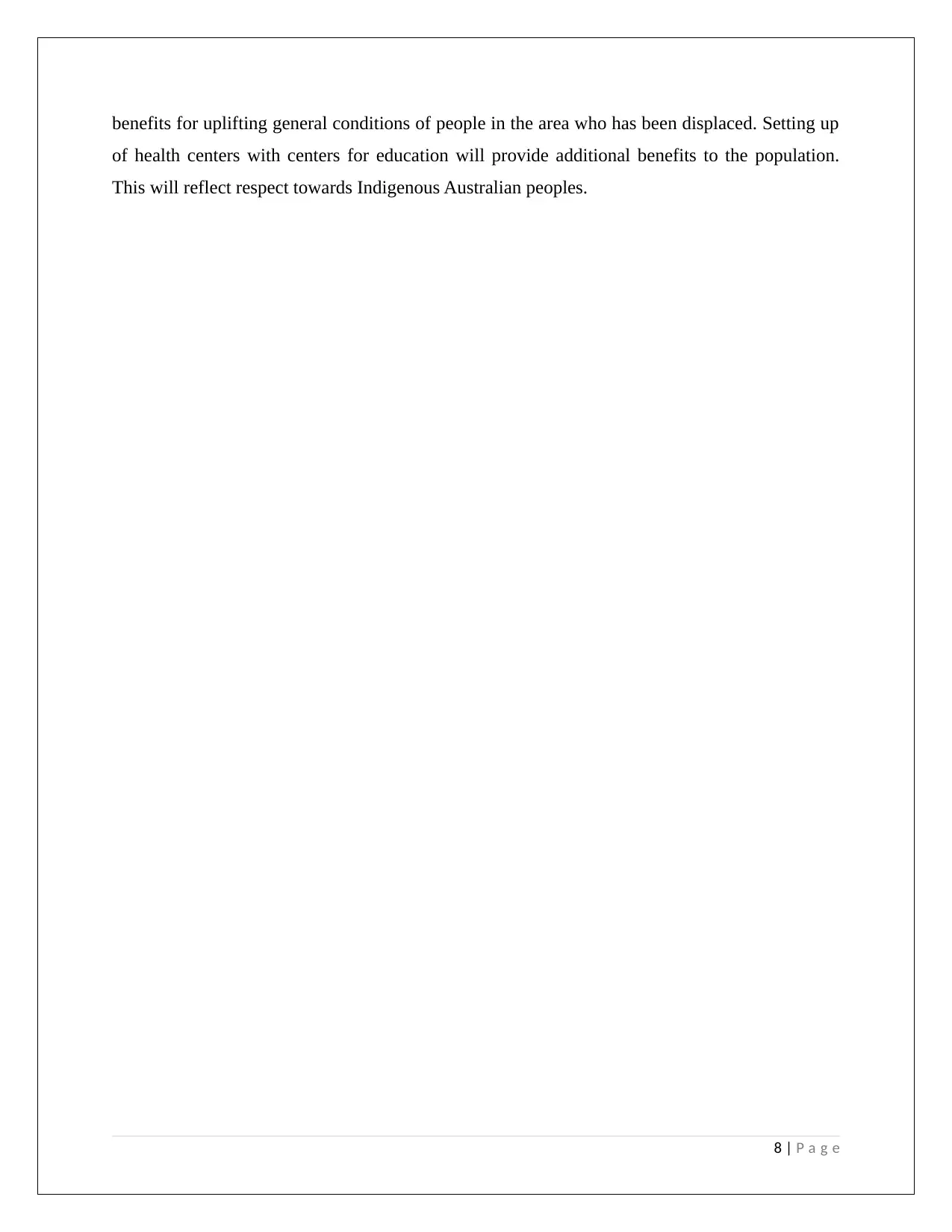
benefits for uplifting general conditions of people in the area who has been displaced. Setting up
of health centers with centers for education will provide additional benefits to the population.
This will reflect respect towards Indigenous Australian peoples.
8 | P a g e
of health centers with centers for education will provide additional benefits to the population.
This will reflect respect towards Indigenous Australian peoples.
8 | P a g e
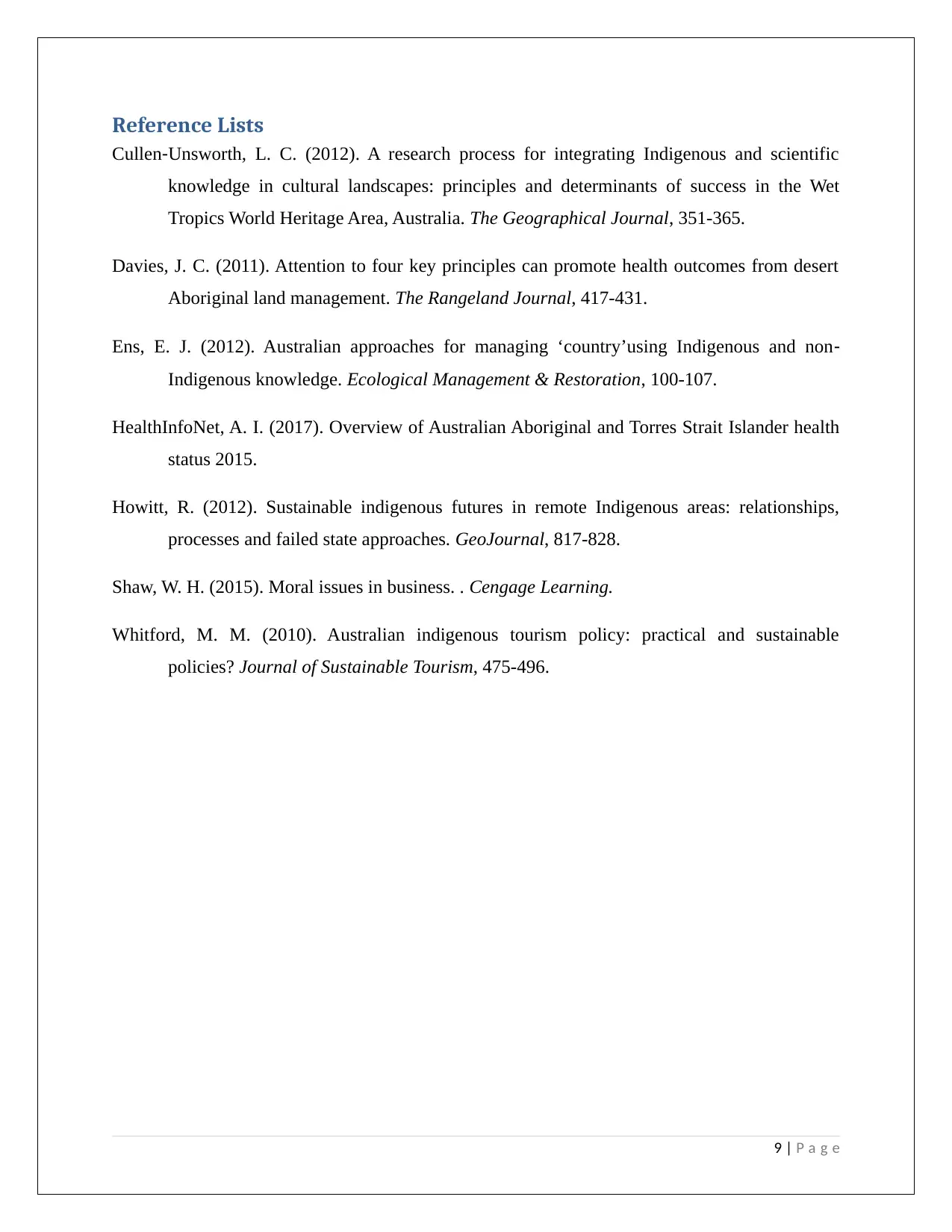
Reference Lists
Cullen‐Unsworth, L. C. (2012). A research process for integrating Indigenous and scientific
knowledge in cultural landscapes: principles and determinants of success in the Wet
Tropics World Heritage Area, Australia. The Geographical Journal, 351-365.
Davies, J. C. (2011). Attention to four key principles can promote health outcomes from desert
Aboriginal land management. The Rangeland Journal, 417-431.
Ens, E. J. (2012). Australian approaches for managing ‘country’using Indigenous and non‐
Indigenous knowledge. Ecological Management & Restoration, 100-107.
HealthInfoNet, A. I. (2017). Overview of Australian Aboriginal and Torres Strait Islander health
status 2015.
Howitt, R. (2012). Sustainable indigenous futures in remote Indigenous areas: relationships,
processes and failed state approaches. GeoJournal, 817-828.
Shaw, W. H. (2015). Moral issues in business. . Cengage Learning.
Whitford, M. M. (2010). Australian indigenous tourism policy: practical and sustainable
policies? Journal of Sustainable Tourism, 475-496.
9 | P a g e
Cullen‐Unsworth, L. C. (2012). A research process for integrating Indigenous and scientific
knowledge in cultural landscapes: principles and determinants of success in the Wet
Tropics World Heritage Area, Australia. The Geographical Journal, 351-365.
Davies, J. C. (2011). Attention to four key principles can promote health outcomes from desert
Aboriginal land management. The Rangeland Journal, 417-431.
Ens, E. J. (2012). Australian approaches for managing ‘country’using Indigenous and non‐
Indigenous knowledge. Ecological Management & Restoration, 100-107.
HealthInfoNet, A. I. (2017). Overview of Australian Aboriginal and Torres Strait Islander health
status 2015.
Howitt, R. (2012). Sustainable indigenous futures in remote Indigenous areas: relationships,
processes and failed state approaches. GeoJournal, 817-828.
Shaw, W. H. (2015). Moral issues in business. . Cengage Learning.
Whitford, M. M. (2010). Australian indigenous tourism policy: practical and sustainable
policies? Journal of Sustainable Tourism, 475-496.
9 | P a g e
⊘ This is a preview!⊘
Do you want full access?
Subscribe today to unlock all pages.

Trusted by 1+ million students worldwide
1 out of 9
Related Documents
Your All-in-One AI-Powered Toolkit for Academic Success.
+13062052269
info@desklib.com
Available 24*7 on WhatsApp / Email
![[object Object]](/_next/static/media/star-bottom.7253800d.svg)
Unlock your academic potential
Copyright © 2020–2025 A2Z Services. All Rights Reserved. Developed and managed by ZUCOL.





